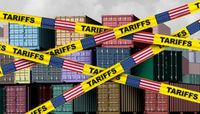Nvidia is navigating a complex landscape as it faces the ramifications of new tariff policies imposed by former President Donald Trump, specifically targeting the booming artificial intelligence (AI) sector. Recent analyses suggest that the company may avoid significant tariff impacts on its AI server products by ramping up production in Mexico, a strategy that could stabilize prices amid rising costs associated with global supply chain disruptions.
On April 7, 2025, Stacy Rasgon, an analyst at Bernstein, conveyed to investors that a substantial portion of Nvidia's data center servers could enter the U.S. tariff-free, primarily due to their manufacturing base in Mexico. Rasgon noted, "Most of Nvidia's AI server shipments are found to originate from Mexico," highlighting that around 60% of these servers are produced there, while approximately 30% come from Taiwan. The Harmonized Tariff Schedule (HTS) indicates that Nvidia's DGX and HGX servers are included in tariff exemptions, a legacy of trade agreements established during Trump's first term.
Despite the U.S. government's classification of Nvidia's GPUs as tax-exempt, the servers themselves, which comprise multiple components, might not enjoy the same status. This discrepancy has raised concerns about potential price hikes in the AI sector, which could impact the broader tech industry's investment strategies. However, Rasgon's analysis offers a glimmer of hope, suggesting that Nvidia's ability to produce servers in Mexico could mitigate these risks.
Nvidia's CEO, Jensen Huang, expressed optimism during the GTC 2025 conference, stating, "In the short term, the impact of tariffs is insignificant." This sentiment reflects a confidence in the company's strategic adjustments to its manufacturing and supply chain operations. As Nvidia expands its production capabilities in Mexico, it aims to shield itself from the adverse effects of the tariffs while maintaining competitive pricing.
In a related move, Apple has also taken steps to avoid hefty tariffs on its products. The tech giant recently shipped five planes of iPhones assembled in India to the U.S., aiming to circumvent a staggering 56% tariff imposed on Chinese imports. This strategy not only helps Apple maintain its inventory but also allows for a more favorable pricing structure in a competitive market. The company plans to increase its iPhone production in India, signaling a shift in its supply chain strategy to reduce reliance on China.
As the technology sector grapples with the fallout from Trump's tariff policies, analysts are closely monitoring the potential effects on Nvidia's operations and market positioning. The new economic policies have sparked uncertainty within the tech industry, with many companies assessing their resilience in the face of these changes. Nvidia, which has long been a leader in AI chip manufacturing, now finds itself at a crossroads, with its market capitalization fluctuating significantly due to these tariff-related concerns.
According to Stephen Witt, author of "The Thinking Machine: Jensen Huang, Nvidia, and the World's Most Coveted Microchip," the political and supply chain challenges facing Nvidia are unprecedented. He noted, "Jensen Huang doesn't talk about politics. He is perhaps the most influential American tech figure who doesn't attend Donald Trump's dinners. Now, Jensen Huang must deal with politics because the turmoil for his business is too severe." This acknowledgment underscores the gravity of the situation as Nvidia navigates the intersection of technology and geopolitics.
Witt outlined three potential paths for Nvidia in response to the tariffs: paying the tariffs, which could hurt profits; relocating manufacturing to the U.S., a politically fraught option; or raising prices. Each choice carries significant implications for the company's future and its standing in the competitive AI landscape.
Moreover, Nvidia's dependence on Taiwan for chip production adds another layer of complexity. As tensions between the U.S. and China escalate, Nvidia must carefully manage its supply chain to mitigate risks associated with geopolitical instability. Witt emphasized that while Nvidia currently enjoys a dominant position in the market, it cannot afford to become complacent. "Nvidia has a temporary monopoly, but it cannot sit still. Competitors could emerge with innovative products that threaten its market share," he warned.
In light of these challenges, Nvidia is investing in research centers and data infrastructure in developing countries, seeking to expand its footprint and diversify its operations. This strategic move aims to bolster its resilience against potential global disruptions and ensure a steady pipeline of talent and resources.
As the tech industry continues to evolve amid changing political landscapes, Nvidia's ability to adapt to these challenges will be crucial. The company's focus on maintaining its competitive edge while navigating tariffs and supply chain complexities will likely shape the future of the AI market.
In conclusion, Nvidia's proactive measures to increase production in Mexico and Apple's strategic shifts in response to tariffs highlight the ongoing adjustments within the tech industry. As both companies seek to navigate the complexities of international trade and geopolitical tensions, their strategies may serve as a blueprint for others facing similar challenges in the rapidly evolving landscape of technology.



